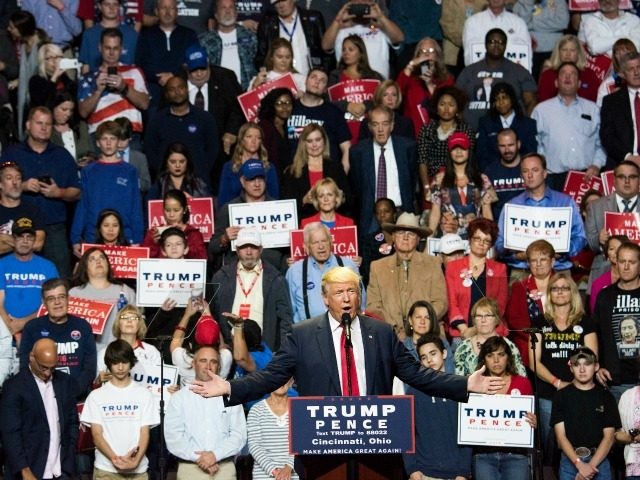Donald Trump tells a crowd of young Ohio voters his program to revive the economy would solve the college debt program to free them to live normal lives and raise families.
“The share of 16-to-28-year-olds not in the labor force has increased to 45 percent during the Obama administration,” said Trump, who has targeted Ohio as one of his must-win states. “In a Trump Administration, we will work every day to make America Great Again for millennials.”
Young Americans need a fighting chance, he said.
“We also have to make sure that those who have graduated college and those who are soon to graduate can find a good job to start a good career when they do,” he said.
“First, we will lower the cost of college and solve the student loan crisis,” he said. “Tuition at public four-year institutions was 40 percent higher in the last school year than it was 10 years ago.”
The New York City developer has focused in many of his events since Sunday’s debate with his Democratic rival Hillary Clinton on WikiLeak-disclosed emails from Clinton’s campaign chairman John Podesta, other ethical challenges faced by Clinton her husband, former president Bill Clinton and Trump’s own challenges with Speaker Paul Ryan and other Republican leaders.
Trump said too many young Americans leave college buried in debt.
“Students should not be asked to pay more on their loans than they can afford, and the debt should not be an albatross around their necks for the rest of their lives,” he said.
“That is why under my student loan program, we would cap repayment to an affordable portion of a borrower’s income–12.5 percent and if borrowers work hard and make their full payments for 15 years, we will let them get on with their lives,” he said.
Government employees get a similar deal right now, he said.
“Every American deserves the same deal, so we will equalize treatment so everyone can start saving for their families and retirement by the time they are 15 years out of college,” he said.
Trump said in addition to addressing the debt burden crushing young Americans, his administration would force colleges cut costs in light of tremendous amount of taxpayers’ money they receive.
“If the federal government is going to subsidize student loans, it has a right to expect that colleges work hard to control costs and invest their resources in their students,” he said.
Trump said he would target the massive endowments that colleges have built up at the same time as tuition and student debt has grown exponentially.
“If colleges refuse to take this responsibility seriously, they will be held accountable–including by reconsidering whether those with huge endowments deserve to keep those endowments tax-exempt,” he said.
“Some schools are paying more to hedge funds and private equity managers than they are spending on tuition assistance–while taxpayers are guaranteeing hundreds of billions of dollars of student loans to pay for rising tuition,” he said. “We want universities to spend their endowments on their students, not themselves.”
The GOP nominee told the packed in crowd of just less than 1,000 that he also was concerned the bloated payrolls at colleges and universities.
“Much of the skyrocketing cost of college education is due to the tremendous bloat in college administrators and bureaucrats,” he said. “According to the Department of Education, the number of college administrators is up more than 60 percent since 1993–10 times the increase in tenured faculty positions.”
Some of the bloat is from the regulations heaped about educational institutions, he said.
“Federal regulations are responsible for much of this administrative bloat. Vanderbilt University estimated that it spends $150 million per year—11 percent of the university’s budget–to comply with government regulations,” he said.
“As president, I will immediately take steps to drive down college costs by reducing the unnecessary costs of compliance with federal regulations so that colleges can pass on the savings to students in the form of lower tuition.”

COMMENTS
Please let us know if you're having issues with commenting.